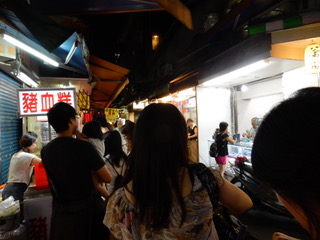I have been eating konjac without any doubt.
Somehow I thought that konjac, which is ordinary gray because hijiki mixed, has a poor taste. But the Sashimi konjac I ate recently was more impressive than I expected, so I decided to research konjac.
Even so, Sashimi konjac is kinds of konjac, so its recognition is that it’s greener (it’s kneaded with seaweed), and it’s more difficult to pick up with chopsticks than normal konjac, normally I ate it with vinegar miso, unlike normal konjac because I thought it would be served normally.
However, it seems that there are various kinds of sashimi konjac when I reserched its variously.
One is Yamafugu (mountain blowfish).
The procedure here is the same as that for making normal konjac, but reduce the water by about 30% and increase the time of kneading konjac.
Add as much lye as normal konjak (Konjac does not formed unless lye is added to konjac flour kneaded with water) and mix it well.
It is true that Mountain blowfish is often said, and if you think of it as a blowfish and eat it, the texture will also seem to be blowfish.
If you slice it thinly, it will more looks like a blowfish.
Regretfully I’ve never eaten blowfish but.
The other one is Torosashi (fresh tuna).
On the contrary, increase the amount of water by 20 to 30%. Make the time for kneading konjac longer than normal konjac. Increase the amount of water that dissolves lye by about 30% and knead well. In contrast to Yamafugu, the chewy texture is pleasing. It doesn’t melt in your mouth like Toro (Because it’s konjac!), but the Sashimi konjac I ate the other day was made in Iidaka Town, Mie Prefecture, surrounded by nature and beautiful water. So I felt as if I was eating a clear water.
I don’t know when konjac came into Japan. No wild konjac has grown in Japan.
The history that konjac was brought to Japan is that there is a theory that came with Taro in the Jomon period(BC3000-BC100) and other theory is that it came with Buddhism. Since konjac potato is a relative of Taro, I feel that it is true that It came to Japan together, and konjac potato has a medicinal effect (sanding out from your body), and it was originally accepted as a vegetarian dish and it is said that it has a connection to Buddhism. I feel like that if I’m told. Imagine Buddhist eating it instead of meat.
The part of the bract that surrounds the konjac flower is called “Butsu-en-ho”(Buddha flame bract), and is also found in other taro plants. This is not a petal but leaves surrounding innumerable buds, and the Buddha flame bract itself looks like a thin Raflesia (a gigantic flower growing in Southeast Asia and the Malay Peninsula, which also has an eerie appearance), but at all different.
A rare konjac is red konjac.This konjac is said to be sold only around Omihachiman in Shiga Prefecture, and its red colour is come from red iron oxide contained in it. When I actually went to Omihachiman, various types of red konjac were sold at supermarkets. When I boiled to remove lye and put it on a plate, it looked like a liver, and I remembered that there was a pig blood cake that I ate at a night market in Taiwan. It is made by mixing glutinous rice with pork blood, steamed it and sprinkled with peanut flour. In the same way, I wondered if this red konjac was sprinkled with peanut flour, but I haven’t tried it yet. A Japanese red armor was shown on the leaflet that was placed at the store where I bought red konjac, and it sounds true that the story that Nobunaga Oda made konjac dye red.
Looking back my konjac journey, even its different kinds of konjac on both, I think that the deliciousness of konjac is depends on deliciousness of water. Just as the quality of the Japanese paper is affected by the beauty of the water that cannot be seen in finished product, the water holded by konjac potato, which is hard to imagine from the outside, seems to influence its deliciousness. It’s yammy to soak it in the Miso, but it’s still better choice to eat with a sliced ginger and soy sauce.

